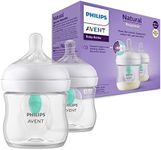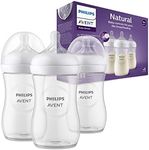Buying Guide for the Best Glass Baby Bottles
Choosing the right glass baby bottle is crucial for your baby's feeding experience. Glass bottles are a popular choice due to their durability, ease of cleaning, and chemical-free nature. When selecting a glass baby bottle, consider factors such as size, shape, nipple type, and additional features that can enhance convenience and safety. Understanding these specifications will help you make an informed decision that best suits your baby's needs and your lifestyle.SizeThe size of a glass baby bottle is important because it determines how much milk or formula it can hold. Bottles typically range from 4 ounces to 9 ounces or more. Smaller bottles are ideal for newborns who consume less milk per feeding, while larger bottles are suitable for older babies with bigger appetites. Consider your baby's age and feeding habits when choosing the size. If you're unsure, starting with a smaller size and gradually increasing as your baby grows can be a practical approach.
ShapeThe shape of a glass baby bottle can affect how easy it is to hold and clean. Common shapes include standard, wide-neck, and angled. Standard bottles are straightforward and fit most bottle warmers and sterilizers. Wide-neck bottles have a broader opening, making them easier to fill and clean, and they often mimic the shape of a breast, which can be helpful for breastfed babies. Angled bottles are designed to reduce air intake, which can help prevent gas and colic. Choose a shape that feels comfortable for you to hold and suits your baby's feeding style.
Nipple TypeThe nipple type is crucial as it affects the flow of milk and the baby's latch. Nipples come in various flow rates, from slow to fast, to accommodate different ages and feeding speeds. Newborns typically require a slow flow to prevent choking, while older babies may need a faster flow to keep up with their increased feeding pace. Additionally, some nipples are designed to mimic the breast, which can be beneficial for breastfed babies transitioning to bottle feeding. Consider your baby's age, feeding habits, and any specific needs, such as anti-colic features, when selecting a nipple type.
Material and DurabilityWhile all glass bottles are made from glass, the type of glass can vary. Look for bottles made from borosilicate glass, which is known for its durability and resistance to thermal shock, meaning it can handle sudden temperature changes without breaking. This is important for safety and longevity, especially if you plan to use the bottles for multiple children. Consider how often you'll be using and cleaning the bottles, and choose a material that can withstand frequent use.
Additional FeaturesAdditional features can enhance the functionality and convenience of glass baby bottles. Some bottles come with silicone sleeves for added grip and protection against breakage. Others may have anti-colic systems to reduce air intake and prevent gas. Consider features like easy-to-read measurement markings, compatibility with breast pumps, and dishwasher safety. Think about your lifestyle and specific needs, such as whether you'll be traveling frequently or need bottles that are easy to clean, to determine which additional features are most beneficial for you.
















